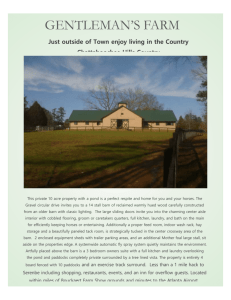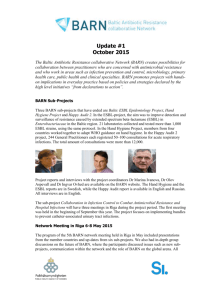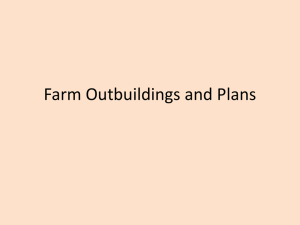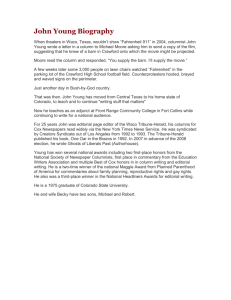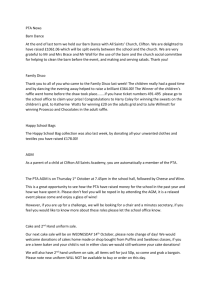1 - Bucks County Audubon Society
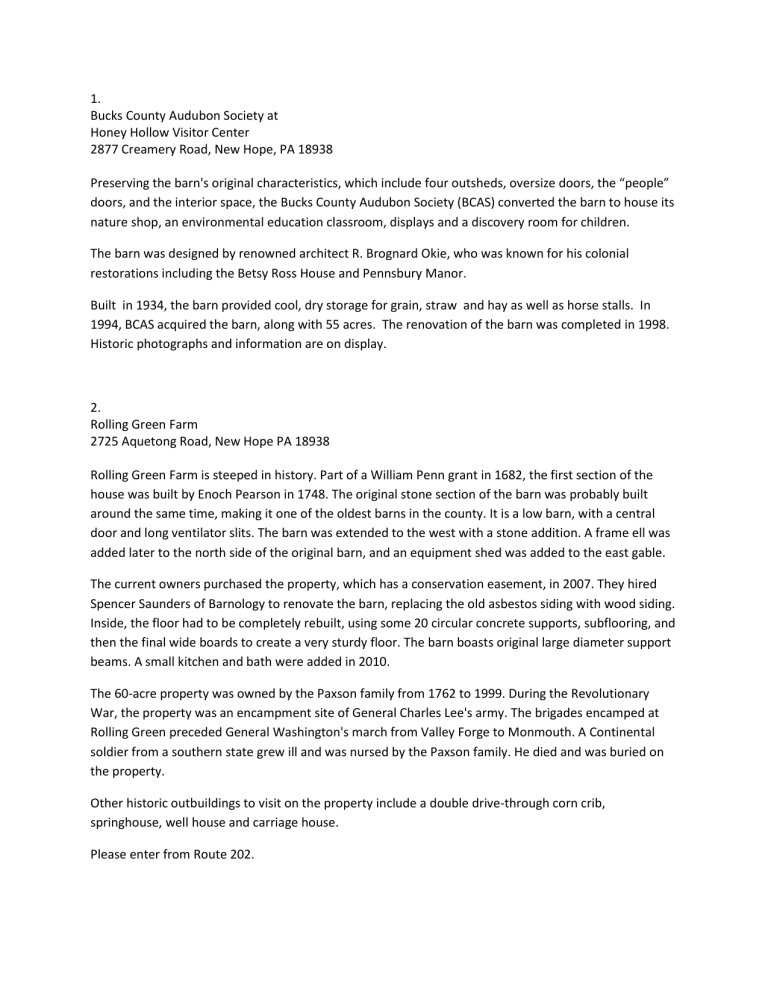
1.
Bucks County Audubon Society at
Honey Hollow Visitor Center
2877 Creamery Road, New Hope, PA 18938
Preserving the barn's original characteristics, which include four outsheds, oversize doors, the “people” doors, and the interior space, the Bucks County Audubon Society (BCAS) converted the barn to house its nature shop, an environmental education classroom, displays and a discovery room for children.
The barn was designed by renowned architect R. Brognard Okie, who was known for his colonial restorations including the Betsy Ross House and Pennsbury Manor.
Built in 1934, the barn provided cool, dry storage for grain, straw and hay as well as horse stalls. In
1994, BCAS acquired the barn, along with 55 acres. The renovation of the barn was completed in 1998.
Historic photographs and information are on display.
2.
Rolling Green Farm
2725 Aquetong Road, New Hope PA 18938
Rolling Green Farm is steeped in history. Part of a William Penn grant in 1682, the first section of the house was built by Enoch Pearson in 1748. The original stone section of the barn was probably built around the same time, making it one of the oldest barns in the county. It is a low barn, with a central door and long ventilator slits. The barn was extended to the west with a stone addition. A frame ell was added later to the north side of the original barn, and an equipment shed was added to the east gable.
The current owners purchased the property, which has a conservation easement, in 2007. They hired
Spencer Saunders of Barnology to renovate the barn, replacing the old asbestos siding with wood siding.
Inside, the floor had to be completely rebuilt, using some 20 circular concrete supports, subflooring, and then the final wide boards to create a very sturdy floor. The barn boasts original large diameter support beams. A small kitchen and bath were added in 2010.
The 60-acre property was owned by the Paxson family from 1762 to 1999. During the Revolutionary
War, the property was an encampment site of General Charles Lee's army. The brigades encamped at
Rolling Green preceded General Washington's march from Valley Forge to Monmouth. A Continental soldier from a southern state grew ill and was nursed by the Paxson family. He died and was buried on the property.
Other historic outbuildings to visit on the property include a double drive-through corn crib, springhouse, well house and carriage house.
Please enter from Route 202.
3.
Schmukler/Doyle Barn
3168 North Sugan Rd, New Hope PA 18938
This c. 1840 barn is a classic, Quaker saltbox bridge barn, of timber frame construction, with closed forebay. The lower stone section has beautiful corner quoins, philosophical inscriptions carved into the beams by a previous owner, and bark remains on the wane side of one of the posts.
The property was once part of the historic Marsh Gibbon Farm on Laurel Road established in 1704 by the Paxson family. The barn was originally built and used by descendants of the Paxson family to support the old Centre Hill Orchard, the remains of which are in the side yard. The property remained in the
Paxson family for more than 200 years.
The function of this barn, with the typical three hay mows and nice bridge on the bank side, has evolved over time. The present owners have embraced its historical past, enjoy the two story stone fireplace, and use it primarily as an entertainment and storage space, complete with a children's theatre. The hay mows now form the basis for a soaring great room and balcony. The barn has been used in recent years for pre-school recitals, Thanksgiving dinners, parties, children's theater productions, woodshop and home office - this barn has seen it all!
It is a wonderful example of a historic structure lovingly maintained to become a focal point of a 21st century's family life.
Visitors can also view the historic carriage barn and gardens in the forebay.
4.
Centre Hill Farm
6704 Paxson Road, New Hope, PA 18938
This barn is a wonderful example of an English, single-level stone barn. One of the most dramatic features are the ventilation slits cut into the stonework. The mason took extra care on the slits on the westerly end of the barn. The stone on either side of the slits were matched to make it appear as though the slits were cut through the stone.
Moses Paxson inherited this property when he turned 21 in 1775 and owned it until his death in 1826.
He married Mary Pownall, the daughter of Simeon Pownall who had a large farm along the Delaware
River near Limeport in 1780. After her death, he married Sarah Paxson, a distant relative.
Major improvements to the property occurred after Moses Paxson took control. He built the tenant house, which has the date 1807 and the initials “M P” carved in stone. Moses's initials are also on the barn and the piggery, with the dates 1785 and 1803 respectively. Scratched in numerous places on the interior plaster are other dates and initials. The 1785 date is the oldest known datestone found on a barn in Bucks County.
5.
Sutphin Barn
4940 Hansell Rd., Mechanicsville, PA 18934
The main section of this barn is a version of a bank barn that is often referred to as a bridge barn because the barn ramp, or bank, did not extend to the barn itself. Instead, a wooden bridge spanned the
gap from the earthen ramp to the barn. There is evidence in the stonework of the barn that there were once sheds on either side of the bridge. This suggests that there may have been a wooden structure called a bridge house protecting the bridge at one time.
Thie Sutphin barn appears to have been built with a frame forebay on the barnyard side which is typical of Pennsylvania German barns and suggests that this barn is of English derivation. Generally these barns had a pent roof spanning the barnyard above the stable doors or each door had an individual hood.
Attached to the end of the barn is a smaller structure that may have been the original barn or a later addition. Another of the interesting features of the barn is the bank of wooden ventilators just under the roofline of the barn.
Also on the tour is a springhouse and lovely gardens.
6.
Gone but Not Forgotten Farm
5237 Curly Hill Rd., Doylestown, PA 18902
This stone bank barn constructed in the early 1800s was once part of a large dairy farm operated by the
Shaddinger family for 3 or 4 generations. At that time Curly Hill was a dirt road and the dairy cows used the road to get from pasture to the barn. Prior to the Shaddingers, the property was owned by Robert
Gibson who was a member of the posse that captured one of the famed Doan brothers, notorious outlaws of the late 1700s. In recent years, the property was divided into the original farmstead, new housing, and preserved open space.
The present owner is caring for the large barn, having recently replaced the roof, the most important maintenance needed to keep these barn structurally sound. This barn has undergone many additions, including frame sections built around the older stone barn. The original stone structure is intact and features two groupings of ventilation slits in the shape of a Maltese cross and huge original beams. The lower section features cow stalls and access to the silo for grain. Colorful hex signs decorate the exterior.
Visitors are encouraged to enjoy beautiful flower gardens below the forebay. Follow parking signs.
7.
Four Brooks Farm
303 Cafferty Road, Pipersville, PA 18947
This c.1800 stone barn has recently been converted into a spectacular home. During some three years of renovation, extra barn wood was set aside and reused when finishing the interior. This barn wood was then used in window framing, stairway railings and balusters, and even the large fireplace. The front door is constructed from the barn's original threshing floor, and the tracks can still be seen in the wood.
The barn-home is sustainably heated and cooled using a two-well geothermal closed loop system.
The barn was once part of a 200-acre working farm. At one time, the property was owned by a church that is located on Smithtown Road and was the site of their summer bible camp. Visitors are free to tour all but one room of this lovely barn conversion.
8.
Nockamixon Lake Barn
2500 Three Mile Run Road, Perkasie, PA 18944
The barn was originally built around 1850 and is a outstanding example of a Bucks County German three-bay bank barn. It was converted to a charming guest house in 2008. Working with the barn owners, Bucks County TimberCraft designed space within the existing footprint and original stone foundation of the barn. The converted barn now serves as a functional entertainment space for visiting guests.
On the main level, the center threshing bay has become a grand welcoming hall and living room that opens to the outside through the use of massive wood framed French doors on both ends, while the flanking mows serve as a Kitchen/Dining area on one side and pool table area and fireplace seating area on the other. The massive oak dining room trestle-leg table was crafted from the barn's original threshing floor, as were all of the barn's new staircases.
Interesting design features include radiant floor heat under Jerusalem Limestone floor slabs on the main level and additional radiant heat under a rustic wood end grain floor tile on the lower level. Each wood floor tile was made by hand by a Bucks County TimberCraft craftsman and grouted and sealed once installed. The railing on the threshing floor steps between the lower level and main level is crafted from a collection of old farm implements and tractor parts.
An adaptive reuse or "green" philosophy formed the basis for many of the design decisions. The barn's original exterior siding became the "new" interior wall surfaces, and additional reclaimed and re-milled barnwood was used on the exterior. The result is a barn that, when viewed by an untrained eye, appears to be gem of an old Bucks County Barn, but in reality is a finely-crafted entertaining space with all the modern amenities and environmental systems accented by centuries of character and patina.
The Nockamixon Lake Barn was featured in the June issue of Architectural Digest. Tthe owners warmly welcome you to visit the barn and its gardens, but ask that you respect their privacy and refrain from venturing to the main farmhouse or its surrounding grounds. Follow parking signs; shuttle provided.
9.
Emele's Antique Barn
443 Route 313 Dublin, PA 18917
This is a large c.1900 timberframe barn. Previously a dairy barn, the current owners have converted it into an antique shop. This barn demonstrates the adaptability of barn structures. This barn has gone through many alterations since its original construction, but remains useful in its new role. Originally it was a standard forebay barn. The basement levels of these barns were masonry, while the superstructure encompassing the loft area was wood frame construction. Openings were filled in with brick or stone, and new, larger doors were installed, as farming practices changed.
The space under the forebay was eventually filled in with cinderblock, most likely when dairying became the dominant farm activity in the early 20th century. The original vast open interior spaces are still marked by timber frame bents, although the spaces have been partially enclosed to serve the current owner's needs. The barn is a testament that these old structures can find new uses if we let them.
Also on the tour is c.1861 wooden carriage barn. It has exposed beams and canted purlin posts on the upper level that are usually not visible in big barns because they are up too high
